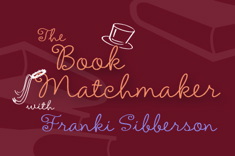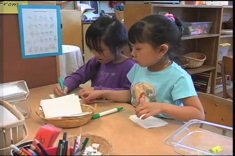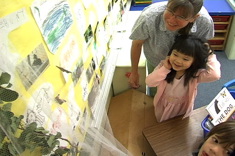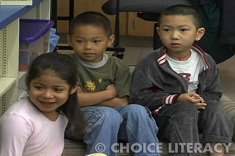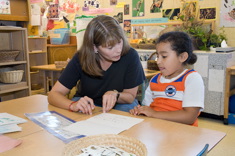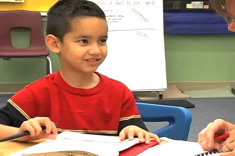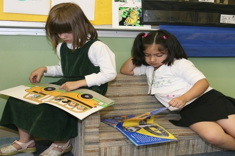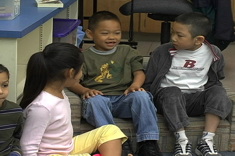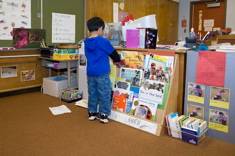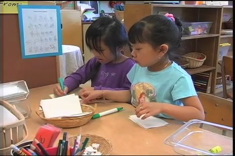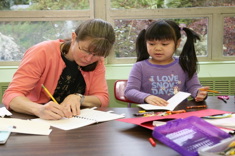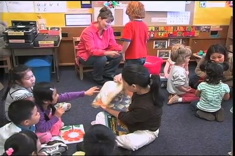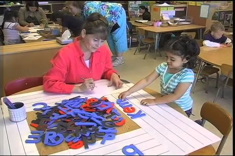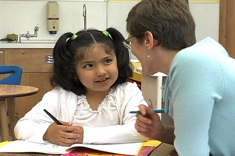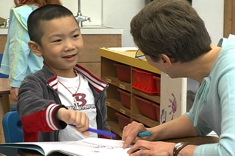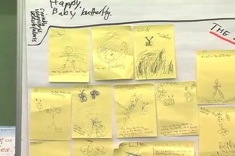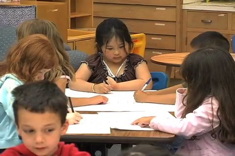English Language Learners
Whether you have one English language learner in your classroom, or hundreds in your school, there is little doubt meeting the needs of these students will be at the top of most schools' agendas for professional development for many years to come.
Latest Content
Book Matchmaker: Texts for 5th Grade English Language Learners
Finding high interest books for English language learners in the upper elementary grades can be a challenge. Franki Sibberson shares some of her favorites.
Preschool Writing Center
In this video from Melissa Kolb’s preschool classroom, children work in the writing center. Melissa explains how she routinely changes the supplies in the center to spark interest in students and make connections to their experiences.
Seven Minutes of Listening
What can we learn by listening closely to children? Plenty — Andie Cunningham shares insights from seven minutes with a young English language learner.
Getting to Know Multilingual Learners at the Start of the Year
If you’re unsure about working with multilingual learners, Stella Villalba has some reassuring advice for you.
Quick Take: Awkward Beginnings with English Language Learners
In this short video, Ruth Shagoury gives two pieces of advice to teachers who feel awkward as they are trying to communicate with young English language learners.
Quick Take: Conferring with Young English Language Learners
In this short video, Ruth Shagoury gives advice to teachers conferring with young English language learners, explaining how other English language learners can be surprisingly helpful in conferences.
Drawing to Learn: Conferring with Kyle
In this conference with six-year-old Kyle, Ruth Shagoury listens to him explain the stories and meaning behind his drawings during writer's workshop. Kyle's first language is Vietnamese, though English is also spoken in the home.
Preschool Morning Message
This five-minute video from Melissa Kolb's preschool classroom shows the value of morning message for teaching literacy skills. Melissa explains the skills children develop during this brief whole-class lesson and sharing time.
34 Languages
What is the starting point for building community in a preschool classroom where almost every child speaks a different first language than their teacher? Melissa Kolb writes about how she gently guides her preschool students early in the year.
Books and Activities from Around the World to Celebrate the Holiday Season
People around the world celebrate the holidays in different ways, and that diversity provides wonderful learning opportunities this time of year. Stella Villalba shares literary holiday projects and a booklist around the themes of “peace” and “wishes” that might help students find common ground in family traditions.
Digital Handouts: An Alternative to More Paper and Meetings
Jill Ostrow creates a flexible and practical online tool to support teachers of English language learners.
Preschool Book Browsing Time
This five-minute video from Kelly Petrin's preschool classroom shows the value of book browsing time. Kelly explains the skills children develop in language, book handling skills, and literacy independence during this time.
Drawing to Words: Conferring with Luis
In this four-minute video, Andie Cunningham confers with Luis during writing workshop. Luis is a six-year-old English language learner whose passion is drawing.
Choosing New Books for Comprehension Strategy Studies with Young Children
Ruth Shagoury and Andie Cunningham share a wealth of books appropriate for comprehension study with young children. The booklist is especially useful for work with English language learners.
Bilingual (English/Spanish) Books that Celebrate Language, Family and Culture
Stella Villalba shares her favorite bilingual (English/Spanish) books for helping young English language learners feel at home in new classrooms early in the year.
Multicultural Books for Beginning Readers
“Why isn’t there an African American Henry and Mudge?” asks a teacher. This question leads Shari Frost on a quest to find the best early readers for multicultural students. In this booklist, she highlights her top picks.
Preschool Letter Detectives
Andie Cunningham works with three-, and four-year-olds as they become "letter detectives." This activity is a wonderful bridge between children's natural curiosity and the alphabet, suitable for preschoolers or kindergartners.
On Not Fretting
Kelly Petrin’s meditation phrase for the day—Do not fret; it only leads to evil—guides her through a home visit with a parent who worries about her daughter’s literacy skills. This is a terrific short read for thinking through how to make encounters with parents less stressful.
Animals as Ambassadors: Using Class Pets to Reach an English Language Learner
When a student is struggling, language barriers can make it even harder for teachers to connect. Andrea Smith finds webbing during conferring is an excellent strategy for assisting a young English language learner in her writer's workshop.
Selecting Texts for Strategy Teaching with English Language Learners in Mind
Text selection for English language learners poses special challenges. Clare Landrigan and Tammy Mulligan explain how the criteria for “just-right books” are different for ELLs, and provide practical examples of how teachers use these principles of book selection in their classrooms.
Many Languages, Many Texts: Book Time in Preschool
In this brief video, Melissa Kolb explains "Book Time" in her preschool class. It's a time when many volunteers read books informally to small groups of children in their home languages.
Conferring with Emily: Moving from Questions to Content
In this conference with six-year-old Emily, Ruth Shagoury looks for a way into a conversation by using Emily’s drawings, previous writing, and interests. Emily’s first language is Hmong, and she is experimenting with Chinese characters in her writing.
Keeping the M
Melissa Kolb confers with three-year-old Daniela and explains why approximations are crucial for young literacy learners.
Conferring with Leonela: A Two-Day Progression
Leonela is a six-year-old student whose first language is Spanish. In these videos of conferences with Ruth Shagoury filmed over two days, she makes connections between her drawing, writing, and experiences at home and in Mexico.
Conferring with Eddie
Eddie is a six-year-old student who speaks Cantonese as his first language. In this conference with Ruth Shagoury, little English is spoken, and yet there is much communication through gestures and shared history.
Creating Anchor Charts with Sticky Note Responses from Young Readers
Over-sized sticky notes are a great learning tool for kindergartners. In this video, Andie Cunningham demonstrates how she uses them with her students.
In the Zone: Conferring with a Young English Language Learner
Andie Cunningham confers with kindergartner Cristian within his "ZPD" – Zone of Proximal Development.
Understanding the “Silent Period” with English Language Learners
Ruth Shagoury and Andie Cunningham explain how to support an English Language Learner who is not speaking with verbal and nonverbal communication strategies.
The Art of Listening in Writing Conferences with English Language Learners
Ruth Shagoury and Andie Cunningham share tips for mastering the art of listening in conferences with English language learners.
Webbing to Learn: A Writing Strategy to Chart Thinking with Young Learners
Andie Cunningham and Ruth Shagoury explain how webs can be a powerful organizing tool for kindergarten writers.
Browse Content By
Type
Category
- Assessment Tools
- Big Fresh Archives
- Booklists
- Choice Numeracy
- Classroom Design
- Common Core
- Community Building
- Conferring
- Content Literacy
- Digital Literacy
- English Language Learners
- Equity
- Family Relations
- Free Samples
- Guiding Groups
- Leadership
- Literacy Coaches
- Mentor Texts
- Minilessons
- New Teacher Mentors
- Podcasts
- Poetry
- Quote Collections
- Reading Strategies
- Self Care
- Struggling and Striving Learners
- Talking and Listening
- Teacher Study Groups
- Teaching Reading
- Teaching Writing
- Word Study and Vocabulary
Author
- Melissa Quimby
- Nawal Qarooni
- Gwen Blumberg
- Julie Cox
- The Lead Learners
- Hannah Tills
- Josie Stewart
- Ruth Metcalfe
- Mallory Messenger
- Becca Burk
- Jodie Bailey
- Vivian Chen
- Mary Brower
- Tiffany Abbott Fuller
- Stephanie Affinito
- Ruth Ayres
- Leigh Anne Eck
- Heather Fisher
- Shari Frost
- Julie Johnson
- Suzy Kaback
- Gigi McAllister
- Shirl McPhillips
- Melanie Meehan
- Cathy Mere
- Debbie Miller
- Tara Barnett and Kate Mills
- Tammy Mulligan
- Dana Murphy
- Bitsy Parks
- David Pittman
- Brenda Power
- Heather Rader
- Matt Renwick
- Mandy Robek
- Christy Rush-Levine
- Gretchen Schroeder
- Jen Schwanke
- Brian Sepe
- Katherine Sokolowski
- Stella Villalba
- Jennifer Vincent
Grade Level
Choice Literacy Membership
Articles
Get full access to all Choice Literacy article content
Videos
Get full access to all Choice Literacy video content
Courses
Access Choice Literacy course curriculum and training

